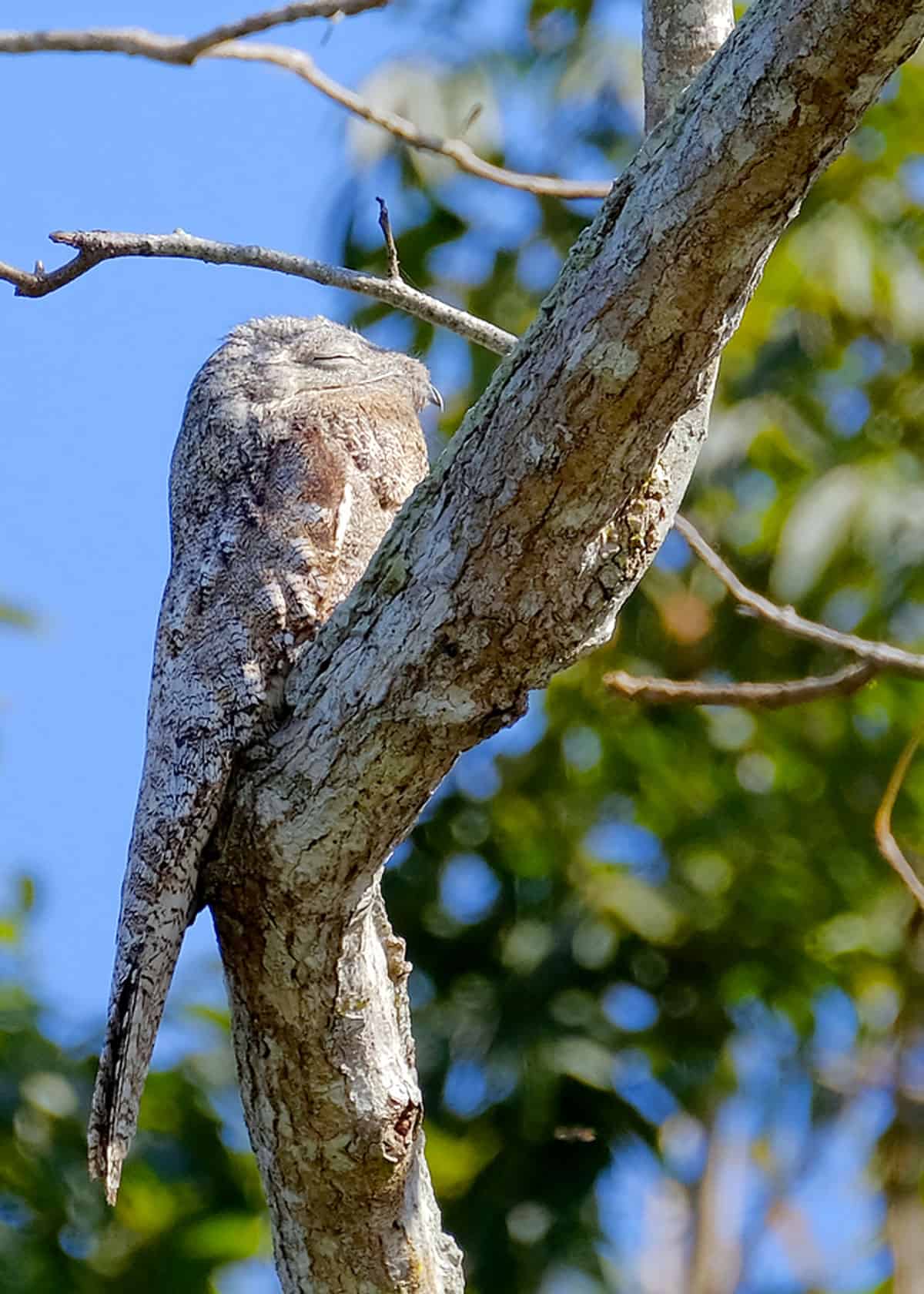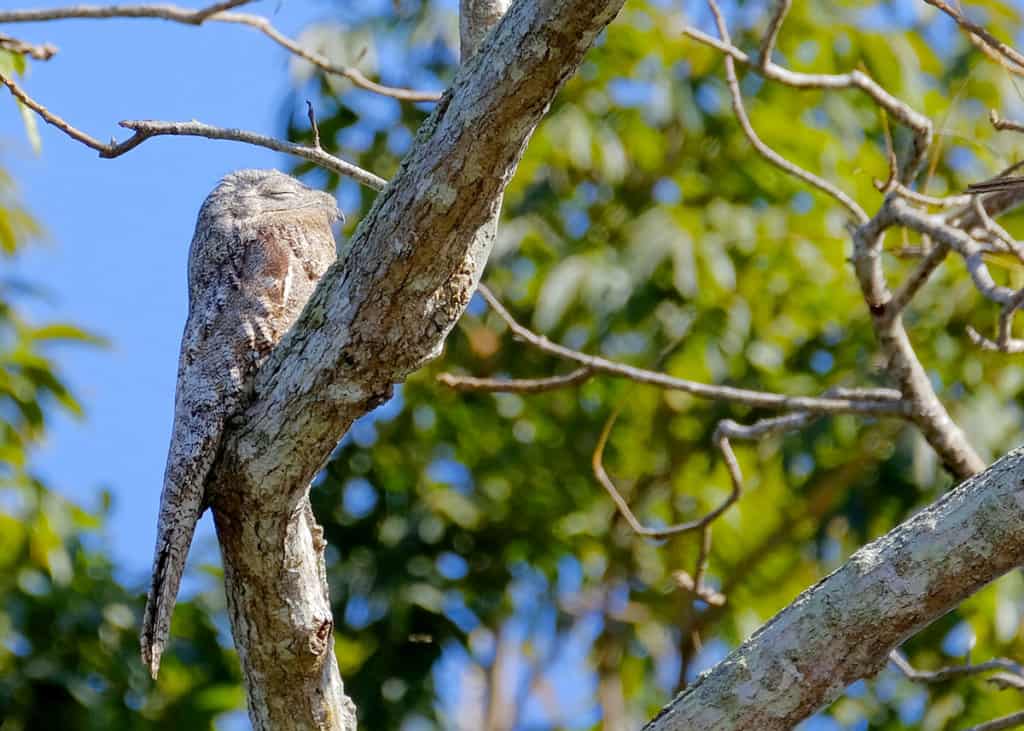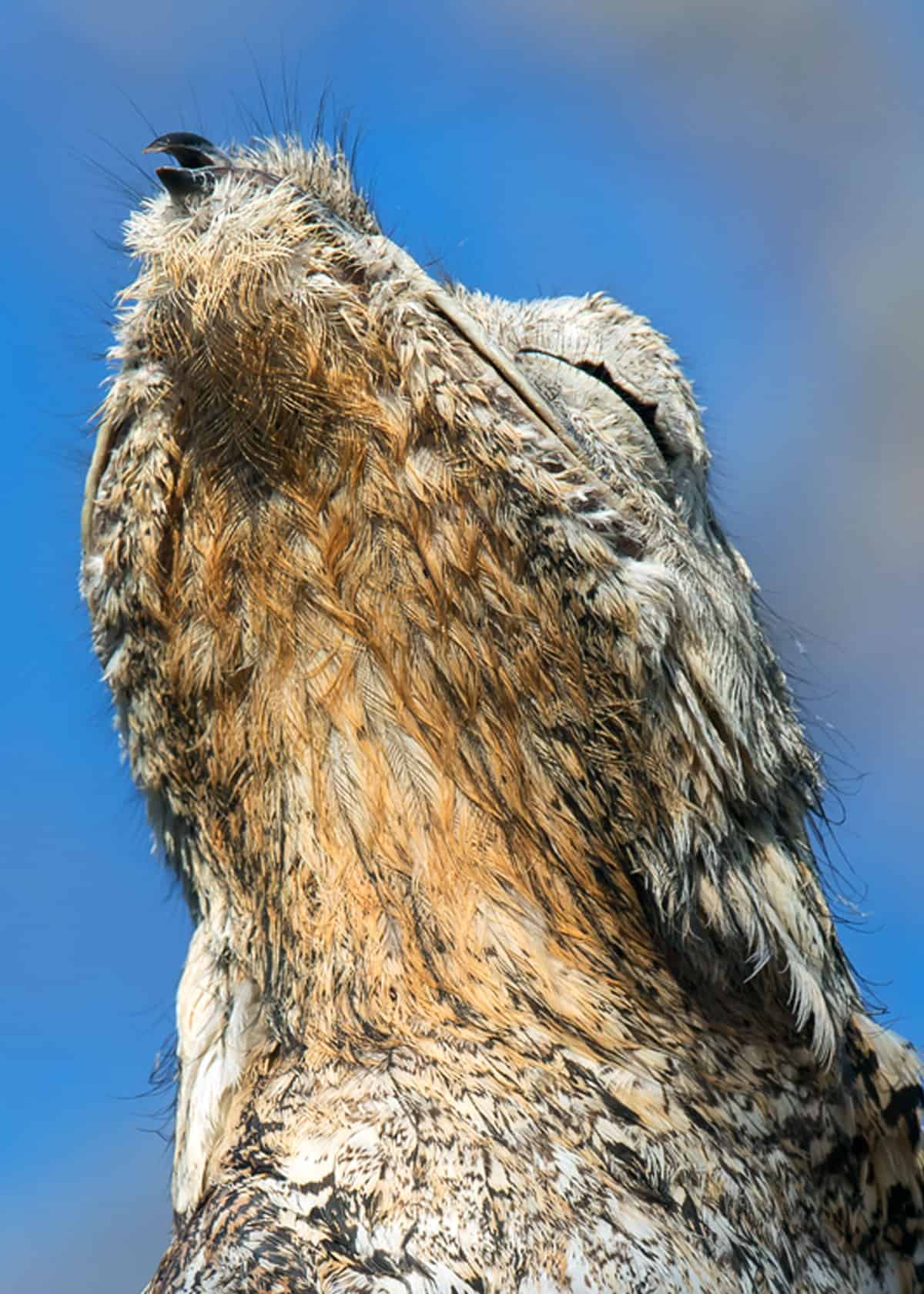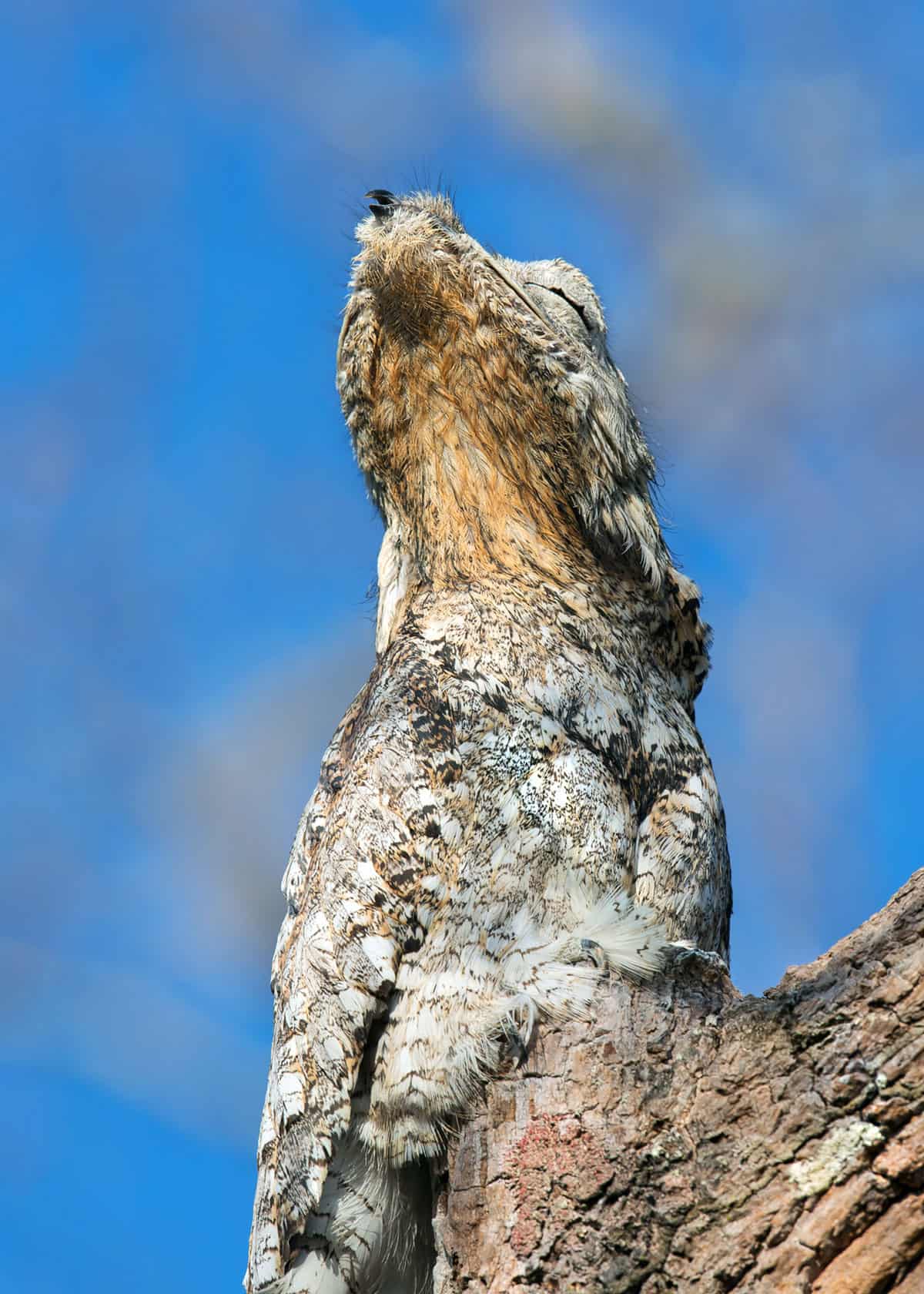Looking for the truth behind all the potoo memes and gifs? Here are 31 great potoo facts that you can use to counter your cousin’s next Facebook update.

Table of Contents
31 Great Potoo Facts
With their wide eyes and even wider mouths, great potoos have become something of a meme in the digital realm.
However, these strange-looking birds have a lot more going on than their looks might suggest! Get all the facts here:
1. Is the potoo bird real?
Potoo birds are very real. They might seem like something that was created through Photoshop, but they’re a genuine bird species living in Central and South America.
Something to keep in mind is that their most famously bug-eyed pictures became famous because they caught the potoo at the silliest possible moment or the worst possible angle.
A lot of potoo birds look completely normal, but those aren’t the photos that go viral. It’s normally something a little more like this:
2. What does the great potoo look like?
The great potoo is a medium-sized bird with a stout figure and a large head. It can come in several different colors, including white, gray, brown, burgundy, and reddish-orange.
Some great potoos are completely monochrome; others look tawny with mottled spots on their feathers.

Nearly all great potoos have white bands on their tails. There are 8 – 9 bands in total. No one is quite sure why they exist, but they’re a distinctive feature of the species if you’re trying to spot one in the wild.
Its beak is short and sharp. Its mouth can stretch impossibly wide to help it catch bugs.
Its eyes are usually bright yellow or deep black, and the size of them will depend on the bird. Some of them can be comically large, bulging, or crossed, but others have normal proportions and angles.
3. How big is a great potoo?
The great potoo measures around 18 – 23 inches (45.7-58.4 cm) tall. This makes it both the largest in the potoo species and the largest in their entire genus.
4. How much does a great potoo weigh?
Great potoos usually weigh around 12 – 23 ounces (340-652 g).
5. What is the great potoos wingspan?
The average wingspan of the great potoo is around 28 inches, but this measurement can fluctuate between 27 – 33 inches (68.5-83.8 cm).
6. How can you tell the difference between a male and female great potoo?
You can’t! They look identical. This is actually a source of frustration for ornithologists since it’s hard to determine which gender is hunting, nesting or courting the other.
Researchers still haven’t figured out whether the male or female great potoo incubates their eggs. In some species, it’s purely the job of the female; in other species, the male and female will take turns.
No one knows where the distribution lies for great potoos since no one can tell mom and dad apart.
7. Are great potoos friendly?
Great potoos are too shy to be called friendly. They spend most of their time hidden away in tall tree branches, and they’re solitary creatures who don’t even live in groups with others of their own kind.
They’re also quite skittish when it comes to danger. While they aren’t afraid to swoop down with spread wings and an open beak to catch their prey, they’re also considered prey themselves, so they have built-in defense mechanisms that involve camouflaging themselves and hiding in plain sight.
8. How long do great potoos live?
No one actually knows the lifespan of the great potoo. It’s another one of their mysteries. If we go by similar bird species, it’s probably somewhere around 12 – 14 years, but this is just a guess.
9. Are great potoos nocturnal?
Yes, great potoos are nocturnal birds. Great potoos are largely inactive during the day, but they come alive around sunset. Everything about them is designed for nighttime hunting and flying.
For example, their big, glossy eyes might look strange during the day, but they provide excellent night vision. They’re so luminescent that they can reflect things like flashlights and headlights.
10. What eats a great potoo? Predators and Threats
Great potoos are vulnerable to weasels, falcons, howlers, spider monkeys, and capuchin monkeys. They can be killed as adults or snatched as eggs.
11. How do great potoos defend themselves from predators?
Rather than fighting, great potoos use camouflage to escape detection from predators.
Since their coloring is often identical to the trees that they reside in, they’ll go motionless when a dangerous animal approaches.
Some of them will even angle their beaks upwards to make themselves look like a jutting branch.

Sometimes, if great potoos have a numbers advantage, they’ll engage in “mobbing” behavior where they swarm the predator to drive it off. But this is quite rare.
For starters, they aren’t aggressive birds to begin with; they’re also solitary creatures, so a whole flock of great potoos in one habitat is quite uncommon.
12. Is the great potoo endangered?
No. According to the International Union for the Conservation of Nature (IUCN), great potoos are ranked as “least concern” in terms of potential extinction threat.
Their population is on a downward decline, but it isn’t considered serious enough to merit any action; great potoos cover a broad range and aren’t being fragmented by habitat loss, so their overall species is a stable one even if their numbers are decreasing.
13. What do great potoos eat?
Great potoos are mostly insectivores that go after moths, beetles, crickets, grasshoppers, and katydids. They’ll occasionally take down a bat or a small bird, but this is rare.
The feeding process is something to behold. While great potoos usually rest on tree branches 30 – 40 feet from the ground, they’ll hop to branches about 5 – 10 feet from the ground when it’s time to hunt. Once they see something gliding across their vision, they strike.
You see, most of their prey is flying prey, and that’s how great potoos hunt as well. They swoop through the sky and catch the bugs and bats in mid-air.
Their wide mouths are their greatest asset; they essentially use them as nets for grabbing their prey with a single snap.
They don’t usually consume their insects right away, however. They’ll fly back to their perches and enjoy their meal from the comfort of their camouflage.
14. What is the great potoos Latin name?
The scientific name of the great potoo is nyctibius grandis.
There used to be two recognized sub-species, nyctibius grandis guatemalensis and nyctibius grandis grandis, but these are outdated. You’ll only see them referenced in older books and encyclopedias.
Potoos are also known as “urutau’s” in Brazil, I believe this name is Portuguese? Let me know in the comments! This video was taken in Brazil:
15. What other names does the great potoo have?
Potoos are sometimes known as “poor-me-ones” because of their haunting nighttime calls.
This isn’t limited to the great potoo, however. It also applies to breeds like the common potoo and the long-tailed potoo.
16. Can the great potoo see with its eyes closed?
Yes. Great potoos are born with special notches on their upper eyelids that allow them to see and sense movement even when their eyes are closed.

Can you see the slits in his eyes?
It’s thought that this might have something to do with the nocturnal nature of their vision, or it could be related to the way that they tilt their heads up whenever danger is near.
Having slits in their eyelids might allow them to see in two directions at once.
17. Do great potoos mate for life?
It’s unknown if great potoos truly mate for life, but they do seem to form monogamous pairs for the breeding season.
Males and females will stick together until their hatchling is grown.
18. How often do great potoos lay eggs?
Breeding season for the great potoo is usually February – August, but it isn’t uncommon for females to lay eggs at any time of year.
There might be some correlation to the wet season of their particular country.
For example, great potoos in Surinam lay their eggs in November, and great potoos in Columbia breed between March and April. Both of these periods are the wet seasons for their regions.
As for the frequency of the great potoo’s egg-laying, this is another area where there isn’t a lot of information, but it’s generally assumed that they only lay one egg per breeding season.
19. How many eggs does the great potoo lay? What do they look like?
Great potoos lay one egg at a time, and since they only lay one egg per breeding season, this single egg represents their whole reproductive cycle for the calendar year.
The good news is that it’s a hefty egg. It measures 1 – 2 inches and is usually white with gray, brown or dark purple spots.
Since males and females look so much alike, it isn’t known how much or how often the mated pair will share incubation duties.
All that researchers know for sure is that someone tends to the egg while their partner brings back food and looks out for predators.
The egg hatches after about a month.
20. What do great potoo babies look like? How fast do they grow?
Young hatchlings weigh around seven ounces and are covered in a white down. They mature quickly, sprouting feathers within two weeks and leaving the nest within four weeks.
By 1.5 months, they’re no longer being fed by their parents. By 2.5 months, the great potoo is fully independent and ready to live on their own.
21. Do great potoos live in groups?
No. Great potoos are solitary animals that only come together for breeding.
Mated pairs will work together to incubate, feed, shelter, and guard their young, but once their hatchling is grown, there’s no indication that they remain together permanently.

That said, there hasn’t been any observed aggression in great potoos that cross paths accidentally.
In fact, they’ve even been known to help each other by signaling danger or mobbing predators. This suggests that their solitary nature is a preference rather than any kind of aggressive or territorial instinct to be alone.
22. What is the great potoo’s call? Why is it so scary?
Great potoos have two distinct calls that will send shivers down your spine.
The first is a loud, human-like “wop” or “whoooap.” It sounds a lot like a moan, and it’s emitted continuously throughout the night.
The other call is a deep, throaty “baaaao.” It sounds more like a croak than a moan, and it’s rarer than the other noise, but it also has a human-like tenor.
Many people compare this call to a disgruntled teenager calling his mom. Can you hear it?
Both calls are so distinct that they’ve given the great potoo a reputation for eeriness.
Between the unique nature of the sounds and the fact that they’re produced in deep, dark forests in the dead of night, they’re considered one of the scarier calls in the animal kingdom.
23. Are great potoos loud?
Yes, great potoos can be quite loud.
Their volume and projection haven’t been officially measured, but anecdotal reports suggest that they can be heard from far distances.
24. How do great potoos groom themselves?
Great potoos clean their feathers by using their legs to scratch up and above their wings. This makes them different from other birds that bring up their legs below their wings.
It’s a subtle but significant variation that can be used to distinguish great potoos from other species while bird-watching.
25. What superstitions surround the great potoo?
Great potoos are the source of many superstitions in both ancient and modern South American culture.
One belief is that the moan of a great potoo is a sign of impending death. Another is that it signifies lost, separated, widowed, or unrequited lovers.
One notable superstition is that it is bad luck to mock a great potoo or its noises, but this one has definitely been disproved by all of the memes!
The most famous legend of the great potoo comes from the Shuar people of Ecuador.
It’s said that the great potoo originated from the spirit of a woman who transformed into a bird after falling from the sky. She was chasing her husband, the moon, but she couldn’t reach him. According to legend, the potoo’s call is the woman crying “aishirú, aishirú” (“my husband, my husband”) every night.
26. Where does the great potoo live?
The great potoo is native to Central and South America. If you look at a distribution map, you can see that its range extends from southern Mexico to southeastern Brazil.
There have been a few wild great potoos spotted in other regions, but they’re considered vagrants rather than signs of a settled population.
27. Can you eat a great potoo?
There are villages in rural South America that will eat great potoo, but since the birds are hard to locate and small in stature, they aren’t considered a viable food source.
There just isn’t enough meat on their bones to make hunting them a worthwhile pursuit.
28. Do great potoos have any other uses?
People in Brazil will use the feathers and body parts of a great potoo in cultural ceremonies.
They see great potoos as symbols of chastity, so some believe that the bird can help them ward off seduction.
29. What is the habitat of the great potoo?
Great potoos live in trees. Most of them prefer the coverage of forests and rainforests, but they’ll also strike out to grasslands, woodlands, foothills, forest edges, and even meadows.
The most important thing is that there are trees nearby. Great potoos can’t survive in open plains without branches to shelter and camouflage them.
30. Where do great potoos nest?
Great potoos don’t make true nests. Instead, they lay their eggs in the hollows and depressions of thick tree branches.
An unusual feature of these “nests” is that they’re always at least 30 feet from the ground; while most birds do this to prevent predators from stealing their eggs, great potoos are most threatened by falcons and monkeys.
Altitude won’t help with these predators at all. The best guess of researchers is that the height of the nest has something to do with its camouflaging capabilities.
31. Where can I see the great potoo?
Great potoos can be found at many different zoos, wildlife sanctuaries, and bird conservatories.
If you’re traveling to Central or South America, you can try to spot them in the wild, but it will be difficult. They blend into the trees by day, and they’re stealthy hunters by night.

Forget Meme Not
There’s a story behind every picture, and this is especially true for great potoos.
As these great potoo facts have explained, they actually hold a lot of significance in their native cultures, and they live fascinating lives deep in the rainforests of the equator!
Drew Haines is an animal enthusiast and travel writer. She loves to share her passion through her writing.
She graduated high school at sixteen and started her own business, Everywhere Wild Media. And she runs Everywhere Wild and JustBirding. She also guest blogs on Storyteller.Travel
She lived in Ecuador for 6 years and explored the Galapagos Islands. Currently based in N.S., Canada.

Jill
Monday 20th of March 2023
Thanks for sharing this very interesting information, Drew. Someone posted a picture on Nextdoor and another found a link on YouTube and that's when I heard the Great Potoo's eerie sound. So I decided to find more info and I ended here. Very cool!
Linda harrington
Monday 28th of December 2020
Wonderful
paul cheifield
Thursday 13th of April 2023
@Linda harrington, that’s exactly what i was thinking! great observation linda alice harrington !!!!